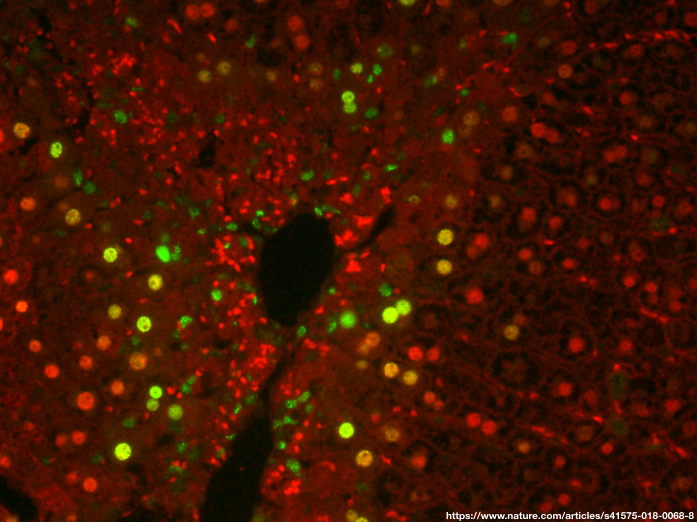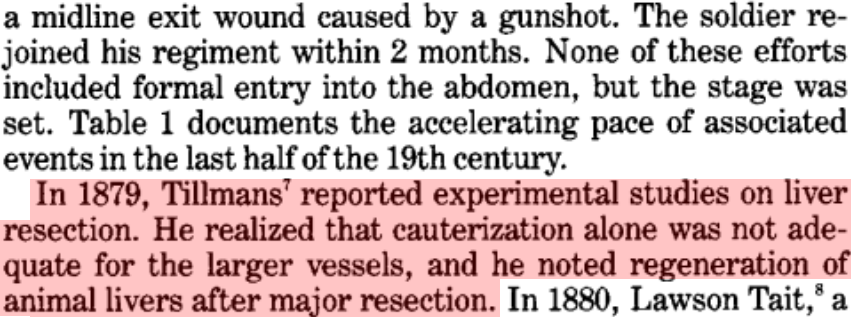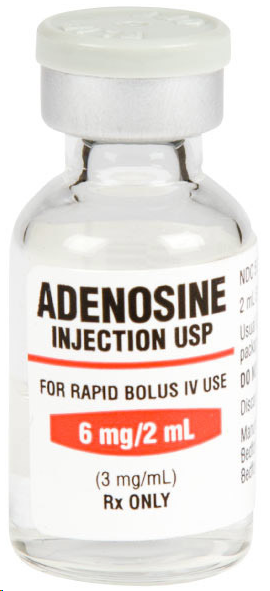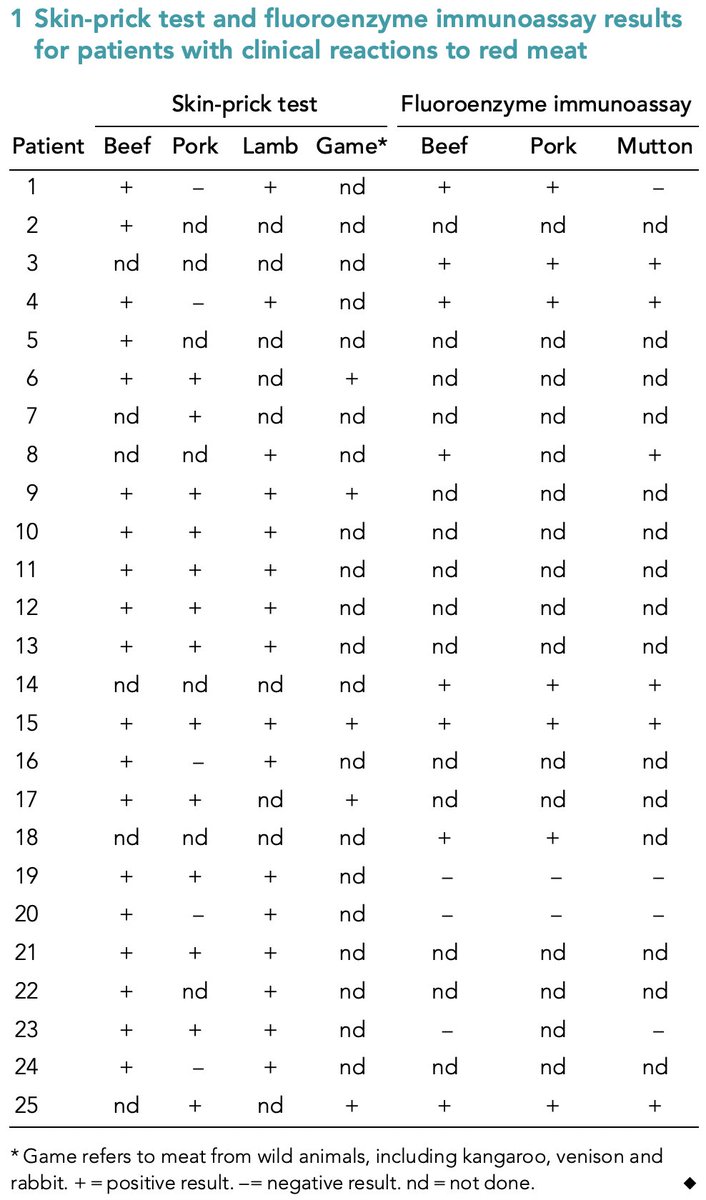
1/THREAD
Why is the liver able to regenerate itself?
Somehow the liver has the incredible capacity to both heal itself after toxic injury and regrow after resection. No other solid organ in the body can regenerate like this.
#medtwitter #tweetorial
Why is the liver able to regenerate itself?
Somehow the liver has the incredible capacity to both heal itself after toxic injury and regrow after resection. No other solid organ in the body can regenerate like this.
#medtwitter #tweetorial

2/
It's assumed that the ancient Greeks knew of the liver's unique regenerative capacity, based on the myth of Prometheus (his liver regrew daily after an eagle ate it).
At the same time, scholars have found no other ancient evidence of this knowledge.
pubmed.ncbi.nlm.nih.gov/20472318/
It's assumed that the ancient Greeks knew of the liver's unique regenerative capacity, based on the myth of Prometheus (his liver regrew daily after an eagle ate it).
At the same time, scholars have found no other ancient evidence of this knowledge.
pubmed.ncbi.nlm.nih.gov/20472318/

3/
Not until the 19th century was liver regeneration demonstrated experimentally.
H. Tillmans, in Germany in 1879, showed that the liver can regenerate after resection in animal models.
pubmed.ncbi.nlm.nih.gov/1998481/
Not until the 19th century was liver regeneration demonstrated experimentally.
H. Tillmans, in Germany in 1879, showed that the liver can regenerate after resection in animal models.
pubmed.ncbi.nlm.nih.gov/1998481/

4/
Hepatic regeneration occurs in all vertebrates, from fish to amphibians to mammals, evolving ~400 million years ago.
This may reflect the liver's centrality to complex life, though it's unknown why no other solid organs developed this ability.
ncbi.nlm.nih.gov/pmc/articles/P…
Hepatic regeneration occurs in all vertebrates, from fish to amphibians to mammals, evolving ~400 million years ago.
This may reflect the liver's centrality to complex life, though it's unknown why no other solid organs developed this ability.
ncbi.nlm.nih.gov/pmc/articles/P…

5/
Up to 80% of a healthy human liver can be resected (partial hepatectomy) and then reliably regenerate, back to its original size and function.
The liver also functionally regenerates in response to toxic injury too.
It's truly incredible.
pubmed.ncbi.nlm.nih.gov/22441614/
Up to 80% of a healthy human liver can be resected (partial hepatectomy) and then reliably regenerate, back to its original size and function.
The liver also functionally regenerates in response to toxic injury too.
It's truly incredible.
pubmed.ncbi.nlm.nih.gov/22441614/

6/
Equally incredible is that the liver regenerates to its pre-resection weight by ~2 weeks (with histological reorganization occurring over months).
Regeneration has also enabled the veritable miracle of live-donor liver transplants.
ncbi.nlm.nih.gov/pmc/articles/P…
Equally incredible is that the liver regenerates to its pre-resection weight by ~2 weeks (with histological reorganization occurring over months).
Regeneration has also enabled the veritable miracle of live-donor liver transplants.
ncbi.nlm.nih.gov/pmc/articles/P…

7/
To understand how the liver accomplishes regeneration after injury or resection, we need to review the microscopic structural units of the liver, known as hepatic lobules...
To understand how the liver accomplishes regeneration after injury or resection, we need to review the microscopic structural units of the liver, known as hepatic lobules...
8/
Each lobule is composed of 3 zones - containing hepatocytes, small bile ducts and capillaries - and is bordered by a series of portal triads.
Blood flows through the lobule, from portal triads in zone 1 to the central vein in zone 3.
amboss.com/us/knowledge/L…
Each lobule is composed of 3 zones - containing hepatocytes, small bile ducts and capillaries - and is bordered by a series of portal triads.
Blood flows through the lobule, from portal triads in zone 1 to the central vein in zone 3.
amboss.com/us/knowledge/L…

9/
So how does the liver regenerate? Let's first look at cell turnover and toxic injuries.
Studies in mice suggest zone 2 hepatocytes (at the center of the lobule) = main source of regenerated liver cells, both w/ normal homeostasis and toxic injury.
pubmed.ncbi.nlm.nih.gov/33632817/
So how does the liver regenerate? Let's first look at cell turnover and toxic injuries.
Studies in mice suggest zone 2 hepatocytes (at the center of the lobule) = main source of regenerated liver cells, both w/ normal homeostasis and toxic injury.
pubmed.ncbi.nlm.nih.gov/33632817/

10/
Exactly what drives zone 2 regeneration isn't clear.
But the same mouse study from tweet #9 found that knocking out Insulin-like growth factor binding protein 2 (IGFBP2) led to loss of hepatocyte repopulation after injury, suggesting a central role of this signaling axis.
Exactly what drives zone 2 regeneration isn't clear.
But the same mouse study from tweet #9 found that knocking out Insulin-like growth factor binding protein 2 (IGFBP2) led to loss of hepatocyte repopulation after injury, suggesting a central role of this signaling axis.

11/
The regenerative role of mid-lobule, zone 2 hepatocytes makes teleological sense.
Zone 1 hepatocytes do oxidative metabolism eg gluconeogenesis; zone 3 hepatocytes do more drug detox.
Zone 2 = regenerative reservoir w/ injury to other zones.
pubmed.ncbi.nlm.nih.gov/34566696/
The regenerative role of mid-lobule, zone 2 hepatocytes makes teleological sense.
Zone 1 hepatocytes do oxidative metabolism eg gluconeogenesis; zone 3 hepatocytes do more drug detox.
Zone 2 = regenerative reservoir w/ injury to other zones.
pubmed.ncbi.nlm.nih.gov/34566696/

12/
With partial hepatectomy (PHx), a global hepatocyte proliferation occurs, as well as hypertrophy of existing cells.
Each major hepatic cell type, including sinusoidal endothelial and bile duct cells, regenerates.
pubmed.ncbi.nlm.nih.gov/9082986/
With partial hepatectomy (PHx), a global hepatocyte proliferation occurs, as well as hypertrophy of existing cells.
Each major hepatic cell type, including sinusoidal endothelial and bile duct cells, regenerates.
pubmed.ncbi.nlm.nih.gov/9082986/

13/
This global regenerative process begins within an hour of partial hepatectomy.
Changes in hepatocyte gene expression, growth factor activity and cytokine/paracrine signaling occur almost immediately.
pubmed.ncbi.nlm.nih.gov/17559071/

This global regenerative process begins within an hour of partial hepatectomy.
Changes in hepatocyte gene expression, growth factor activity and cytokine/paracrine signaling occur almost immediately.
pubmed.ncbi.nlm.nih.gov/17559071/


14/
But how does the liver know it's been damaged after partial hepatectomy (where the un-resected lobes are undamaged)?
What signals the liver to start this regenerative sequence?
How does it "know" that it needs to regenerate?
But how does the liver know it's been damaged after partial hepatectomy (where the un-resected lobes are undamaged)?
What signals the liver to start this regenerative sequence?
How does it "know" that it needs to regenerate?
15/
There are 3 main proposed mechanisms for how partial hepatectomy (PHx) signals the liver to regenerate:
🔺Hemodynamic changes
🔺Innate immune response
🔺Platelets
pubmed.ncbi.nlm.nih.gov/34988214/
There are 3 main proposed mechanisms for how partial hepatectomy (PHx) signals the liver to regenerate:
🔺Hemodynamic changes
🔺Innate immune response
🔺Platelets
pubmed.ncbi.nlm.nih.gov/34988214/
16/
Let's start w/ hemodynamics.
Immediately after PHx there is a dramatic ⬆️ in portal blood flow to the remaining liver.
Example: if 2/3 of the liver is resected then all of the portal blood must flow to the remnant lobes (eg 3x flow).
pubmed.ncbi.nlm.nih.gov/17559071/
Let's start w/ hemodynamics.
Immediately after PHx there is a dramatic ⬆️ in portal blood flow to the remaining liver.
Example: if 2/3 of the liver is resected then all of the portal blood must flow to the remnant lobes (eg 3x flow).
pubmed.ncbi.nlm.nih.gov/17559071/

17/
Animal studies suggest this hemodynamic shift may act as a trigger for regeneration.
A rat PHx model found that when blood flow to the remnant liver was kept constant after resection, and not allowed to increase, regeneration didn't occur.
pubmed.ncbi.nlm.nih.gov/15523397/
Animal studies suggest this hemodynamic shift may act as a trigger for regeneration.
A rat PHx model found that when blood flow to the remnant liver was kept constant after resection, and not allowed to increase, regeneration didn't occur.
pubmed.ncbi.nlm.nih.gov/15523397/

18/
In the same study, increased blood flow to the remnant segments after PHx was required for plasmin to activate hepatocyte growth factor (HGF).
HGF activation via blood flow shifts thus seems to be a key regeneration trigger.
In the same study, increased blood flow to the remnant segments after PHx was required for plasmin to activate hepatocyte growth factor (HGF).
HGF activation via blood flow shifts thus seems to be a key regeneration trigger.

19/
Next let's examine the innate immune response. After PHx, macrophage activation leads to increased NF-kB and IL-6 signaling.
These factors stimulate increased hepatocyte survival and proliferation.
pubmed.ncbi.nlm.nih.gov/31669133/
Next let's examine the innate immune response. After PHx, macrophage activation leads to increased NF-kB and IL-6 signaling.
These factors stimulate increased hepatocyte survival and proliferation.
pubmed.ncbi.nlm.nih.gov/31669133/

20/
Finally, let's look at platelets as a type of regenerative mediator.
Amazingly, living donor liver transplant recipients who received peri-operative platelet transfusion had enhanced graft regeneration at 2 weeks post-op.
pubmed.ncbi.nlm.nih.gov/26720430/
Finally, let's look at platelets as a type of regenerative mediator.
Amazingly, living donor liver transplant recipients who received peri-operative platelet transfusion had enhanced graft regeneration at 2 weeks post-op.
pubmed.ncbi.nlm.nih.gov/26720430/

21/
But why would platelets enhance hepatic regeneration?
The main proposed mechanism involves platelet migration into the liver ➡️ direct contact w/ hepatocytes ➡️ growth factor activation ➡️ stimulation of hepatocyte proliferation.
pubmed.ncbi.nlm.nih.gov/17688880/
But why would platelets enhance hepatic regeneration?
The main proposed mechanism involves platelet migration into the liver ➡️ direct contact w/ hepatocytes ➡️ growth factor activation ➡️ stimulation of hepatocyte proliferation.
pubmed.ncbi.nlm.nih.gov/17688880/

22/
To conclude this discussion, let's explore termination of regeneration.
If you think about it, something must tell the liver that enough regeneration has occurred.
Why doesn't the proliferative process continue ad infinitum?
To conclude this discussion, let's explore termination of regeneration.
If you think about it, something must tell the liver that enough regeneration has occurred.
Why doesn't the proliferative process continue ad infinitum?
23/
No one really knows precisely how the liver "senses" that it's time to stop regenerating.
Current theories focus on a feedback loop between growth factors, TGF-beta 1, and new extracellular matrix, all leading to a return to quiescence.
pubmed.ncbi.nlm.nih.gov/17559071/
No one really knows precisely how the liver "senses" that it's time to stop regenerating.
Current theories focus on a feedback loop between growth factors, TGF-beta 1, and new extracellular matrix, all leading to a return to quiescence.
pubmed.ncbi.nlm.nih.gov/17559071/

24/SUMMARY
💥The liver = only solid organ that regenerates
💥Regeneration after toxic injury = zone 2 hepatocyte proliferation
💥Regeneration after PHx is triggered by increased portal vein blood flow and mediated by growth factors, cytokines and platelet contact w/ hepatocytes
💥The liver = only solid organ that regenerates
💥Regeneration after toxic injury = zone 2 hepatocyte proliferation
💥Regeneration after PHx is triggered by increased portal vein blood flow and mediated by growth factors, cytokines and platelet contact w/ hepatocytes
Post script:
HUGE thank you to the inimitable @ebtapper for providing peer review of this tweetorial!
HUGE thank you to the inimitable @ebtapper for providing peer review of this tweetorial!
• • •
Missing some Tweet in this thread? You can try to
force a refresh























